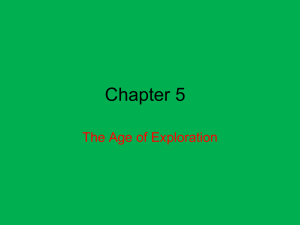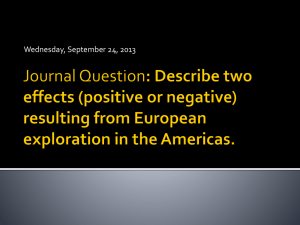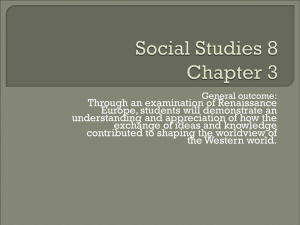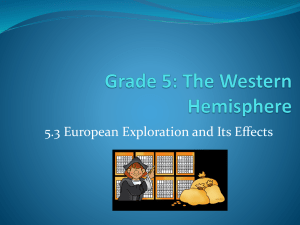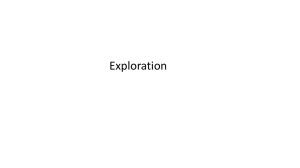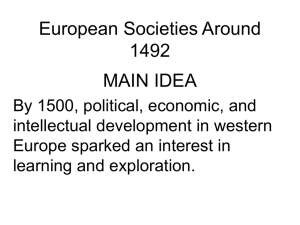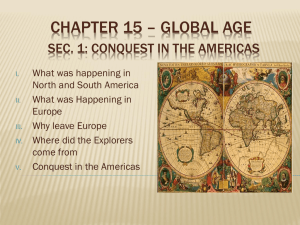Chapter 3
advertisement
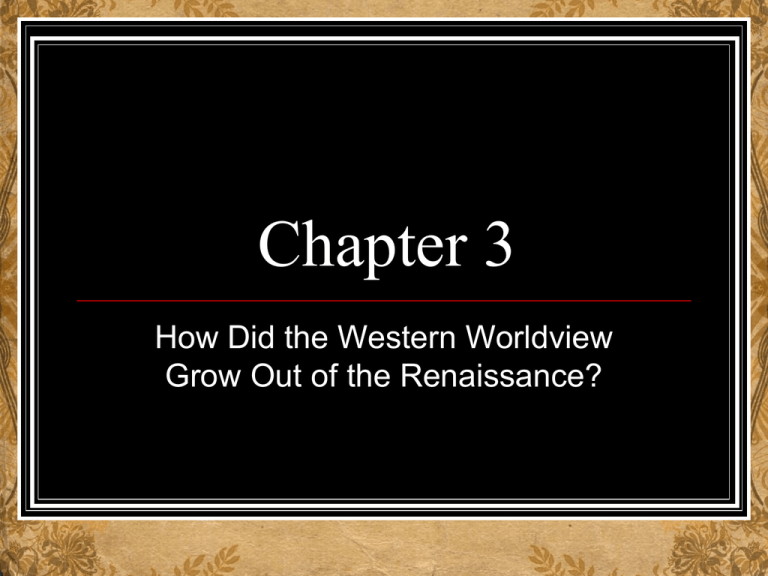
Chapter 3 How Did the Western Worldview Grow Out of the Renaissance? How Did New Religious Views Become Part of the Western Worldview? Two views of religion existed in the Western worldview: MIDDLE AGES HUMANIST Believed that individuals should follow the rules, rituals, and teachings of the RCC Believed that individuals should question and respond to the Bible personally Some questions raised The necessity to follow the Church laws and rituals The actions of the clergy and popes Many wanted to see things reformed, but not break from the RCC This was called the Protestant Reformation Open Books to pg. 91 and read about Martin Luther. No not that Martin Luther Martin Luther What he Believed – Following the rituals was not enough. Seek personal religious understanding. Not pay for forgiveness. What he Did – he wrote 95 church reforms that he felt were necessary What Happened –Books burned. Luther was expelled from the church. John Calvin What He Believed – Believe and practice what is written in the bible only. What He Did – introduced a strict form of Protestantism What Happened – was the central developer of Christian Theology or Calvinism John Knox What He Believed – Believed that the people should govern their local church What He Did – created Presbyteries, or councils of men, to govern the church. Led rebellions. What Happened – led into the Presbyterian church King Henry VIII What He Believed – he believed that he should control the church land. Have his marriage annulled. What He Did – he put himself in charge of church business. What Happened - appointed himself the head of the church of England Spanish Monarchs What they Believed – they believed that all other religions were false and wrong but Catholicism. What they Did – started the Inquisition to find heretics and disbelievers. What Happened – thousands were expelled from the country. Some were jailed, tortured and put to death. How Did Ideas of National Identity and Citizenship Begin to Develop During the Renaissance The idea of Nations began to develop in the Renaissance. Small political units began to join and develop into larger states. These States then became countries because: Societies became more urban Citizens developed new identities of belonging to a state as well as to their local communities Gunpowder was introduced from China, which changed the nature of battles between monarchs and the nobles who owned feudal property The invention of the printing press and the use of local languages helped create national identity Exploration of new lands also led to a sense of greater national identity. How Did a Spirit of Exploration Become Part of the Western Worldview? Governments & traders wanted to expand control of trade around Mediterranean Monarchs wanted to gain the wealth that came from trading with the East New trade routes; increased geographic knowledge; new sailing technologies spurred the start of the Age of Exploration (Discovery) Began in the early 15th century til 17th century Europeans wanted/needed to expand their control to other parts of the world this territorial or economic expansion to other countries is call expansionism Resulted in the spreading of the Western worldview to other continents of the world Factors Affecting Expansionism The Need for New Trade Routes Merchants would form a company and pool their money together to fund trading trips and would share the profits for the sale of goods. Making a profit through trade became an important part of the European world view. “In the Name of God and Of Profit” on account books • Countries like Spain, Portugal, France and England wanted to cut out the middle-men in the trading route. (Italian or Muslim traders) • Wealthy Merchants and Monarchs started to fund new exploratory trading routes to the East New Ideas and Knowledge Geography Aristotle (Greek Philosopher) - believed that the earth was round and flat, like a plate Ptolemy (Egyptian Geographer) - believed that it was round (like a ball) but only one ocean. Islamic and European scientists such as __________ agreed with this Sailors were confident to sail westwards & believed that they could sail west to Asia Interest in Learning More About the World Humanism & Travel Writers created an interest in trade and exploration. Advances in cartography [distribution of maps & navigation tables], navigation [use of astrolabe], and shipbuilding [carracks & caravel] Astrolabe and Compass: Sailors went from always being close to the shore, to being able to navigate in open waters. How did the Age of Exploration Begin? A European desire to expand their influence to other areas of the world became a major part of their worldview. European explorers would spread the Western worldview to all inhabited continents of the world. Portugal, France, Spain and England became the leading players in the Age of Exploration because: POSITION– An Atlantic coastline MONARCHS – Sponsored explorers by financing their voyages. TECHNOLOGY – New ship designs, navigational tools (astrolabe) and navigational information enables explorers to sail the new-world and far-off lands.. The new values of travel & exploration, consumerism and accumulation of wealth fueled the race for new trade routes. The Roman Catholic Church was very involved in the exploration of new lands because it wanted to spread Christianity. Portugal Early 1400’s: Portuguese sailors sailed around the southern tip of Africe to establish a trade route to India & China. The city of Lisbon became the main trading city of Europe. Bartholomew Diaz and Vasco da Gama were 2 of Portugal’s most famous explorers at this time. Spain The Spanish were envious of Portugal’s wealth and started their own series of explorations. Spanish explorers sailed west to try to reach Asia’s eastern shores; however, they did not realize that the Americas were in between Spain and Asia. England England started focusing on exploration in the 16th century. English explorers, Martin Frobisher and John Davis, looked for a North West passage through Canada to India & China. By the 17th century, England had more colonies along the North American Atlantic coast and in the West Indies than any other European power. France At first, France was preoccupied by wars with England and Italy. France sponsored expeditions to areas that were farther north and west. Cartier’s explorations set the stage for France’s future exploration and colonization of the New World. Explorers 1492: Christopher Columbus sailed to what he thought was Japan. In fact he was at an island in the Caribbean. Columbus was sponsored by Queen Isabella and King Ferdinand of Spain. Columbus never reached mainland North America. Explorers 1497: Even though England was not really interested in exploration, the monarch sponsored Giovanni Caboto (John Cabot) who sailed to North America. Explorers 1501: Amerigo Vespucci was an Italian merchant and mapmaker who explored the coast of Brazil. North and South America are named after him. Explorers 1519: Ferdinand Magellan sailed around the tip of South America and named the Pacific Ocean. He reached the eastern part of Asia and his ships were the first to circumnavigate the globe. He was killed in the Philippines. Explorers 1534: France sponsored Jacques Cartier who sailed to the New World and explored up the St. Lawrence river as far north as present day Montreal (then known as Hochelaga). How Did the Age of Exploration Lead to Imperialism? Britain and Spain had built huge empires that spanned the globe. Through policies of imperialism these countries maintained control over the inhabitants and resources of the New World. Built on the desire to increase wealth and power The colonies & land they controlled were to further the interests & increase wealth of home country The European view of the rest of the world Europeans believed that they were culturally and politically superior, therefore they had every right to control the people and resources of these new lands. The indigenous people were not considered as equals. Belief that one’s own race and culture was superior to those people of other societies is known as enthnocentrism Examples of ethnocentrism Aztecs & Incas (Spanish) Chinese & Indians (British, Portuguese) First Nations in N.A (British, French) Africans as slaves Caribbean (Spanish, British) HOW? Government, Religion, Land, Slavery How Did the Exchange of Goods and Products Change the World? The exchange of foodstuffs, metals, plants, animals and diseases affected economies and changed traditional ways of life of people around the world. Europeans introduced: Metals, Wheel, Work animals, Firearms, War technology Product of Americas: Rubber, Canoes, Snowshoes, Toboggans, Chewing gum, Dyes, Medicinal plants How Did the Exchange of Goods and Products Change the World? European diseases had devastating effects on the local Indigenous people who did not have immunity to European diseases. It is estimated that 75% to 90% of the Aboriginal population died as a result of European disease. How Did Imperialism Affect European Worldviews? Ideas & Knowledge Although Europeans considered their way of life as superior, they were impressed by the First Nations ideas of personal liberty, leadership & consensus government and lack of emphasis on personal property. Europeans saw the New World as a place offering new opportunities , free land & escape from religious persecution. Because of the ideas taken from the First Nations, Personal freedom, leadership, individual choice of religion are key parts of the modern Western Worldview. How Did Imperialism Affect European Worldviews? Economic Systems As more gold and silver came into Europe from the New World, its buying power was reduced which resulted in inflation. The price of goods rose due to this inflation which caused hardships for the common people who did not have the wealth from colonies. Spain and France purchased most of their goods from other countries which led to industrialization in countries such as England, Germany and the Netherlands. By the end of 17th century, power was shifting from Spain and Portugal to these countries due to this initial industrial development.


